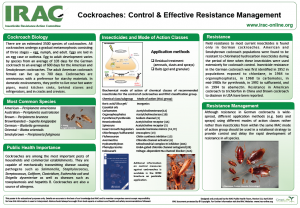Cockroaches
Cockroach SpeciesWorldwide there are approximately 4,500 species of cockroach (also referred to as “roaches”) of which about 30 are associated with human habitats. Of these 3 are well known pests – the German cockroach Blattella germanica is about 15 mm long when fully developed, and light brown in coloration, while the Oriental cockroach Blatta orientalis is shiny black and about 25 mm long. The largest of the three is the American cockroach, Periplaneta americana, which is dark brown and can be over 30 mm long.
Cockroaches are hardy insects and can remain active for several months with little or no food. They have broad, flattened bodies and relatively small heads and are mainly nocturnal and will usually run away when exposed to light. Cockroaches produce eggs in a cigar shaped capsule called an ootheca which is dropped by the female before hatching. The duration of life cycle varies depending on species but in German cockroaches development from egg to adult takes three to four months and an adult female can produce 300 to 400 offspring in her lifetime. Both immature nymphs and adults live in the same habitat (compared with butterflies for example that have a separate caterpillar stage). Oriental and American roaches have longer lifespans with American roaches living up to 6 months.
These three cockroach species are pests as they tend to live in close proximity to humans especially where food handling and hygiene standards are poor. Their ability to passively transport microbes such as Escherichia coli and Salmonella typhi on their body surfaces and disseminate microbes in their feces has linked cockroaches to outbreaks of food poisoning. Roach feces are known to cause allergic reactions and asthma in humans. Aside for the direct health impacts of having cockroaches in places such as homes, schools and hospitals, many people have a deep fear of insects, and cockroaches are no exception.
Cockroaches can become adverse to non-insecticidal components of the baits often used in their control, e.g. glucose. In this case the cockroaches won’t take the bait, but remain susceptible to the insecticide. Replacement of the bait component they have become adverse to can restore the effectiveness of the bait.
Cockroaches resistance profile
Populations of cockroaches resistant to one or more of the major classes of insecticide used in the their control have been reported: Organophosphates – Group 1B Organochlorines – Group 2A Phenylpyrazoles – Group 2B Pyrethroids – Group 3A Neonicotinoids – Group 4A Indoxacarb – Group 22A
